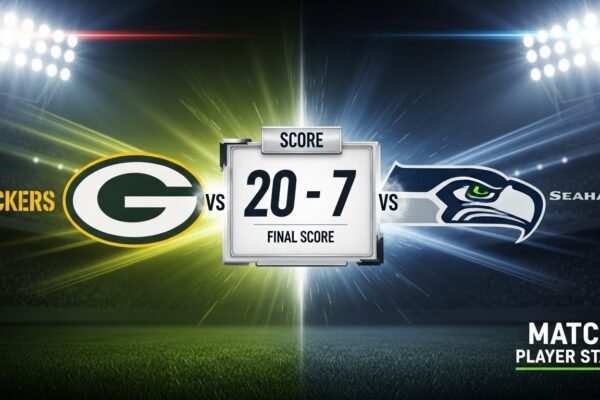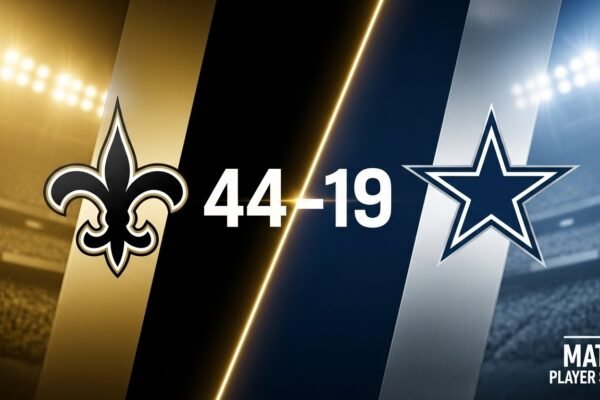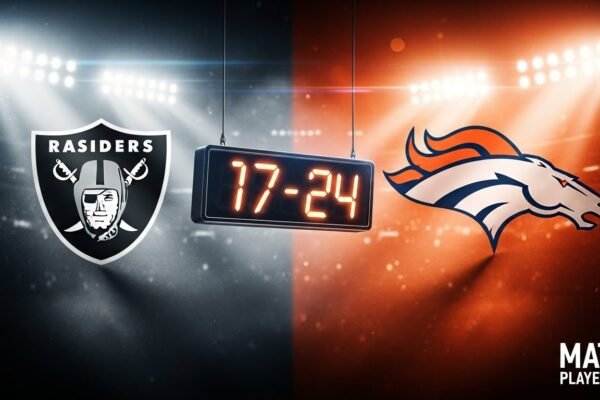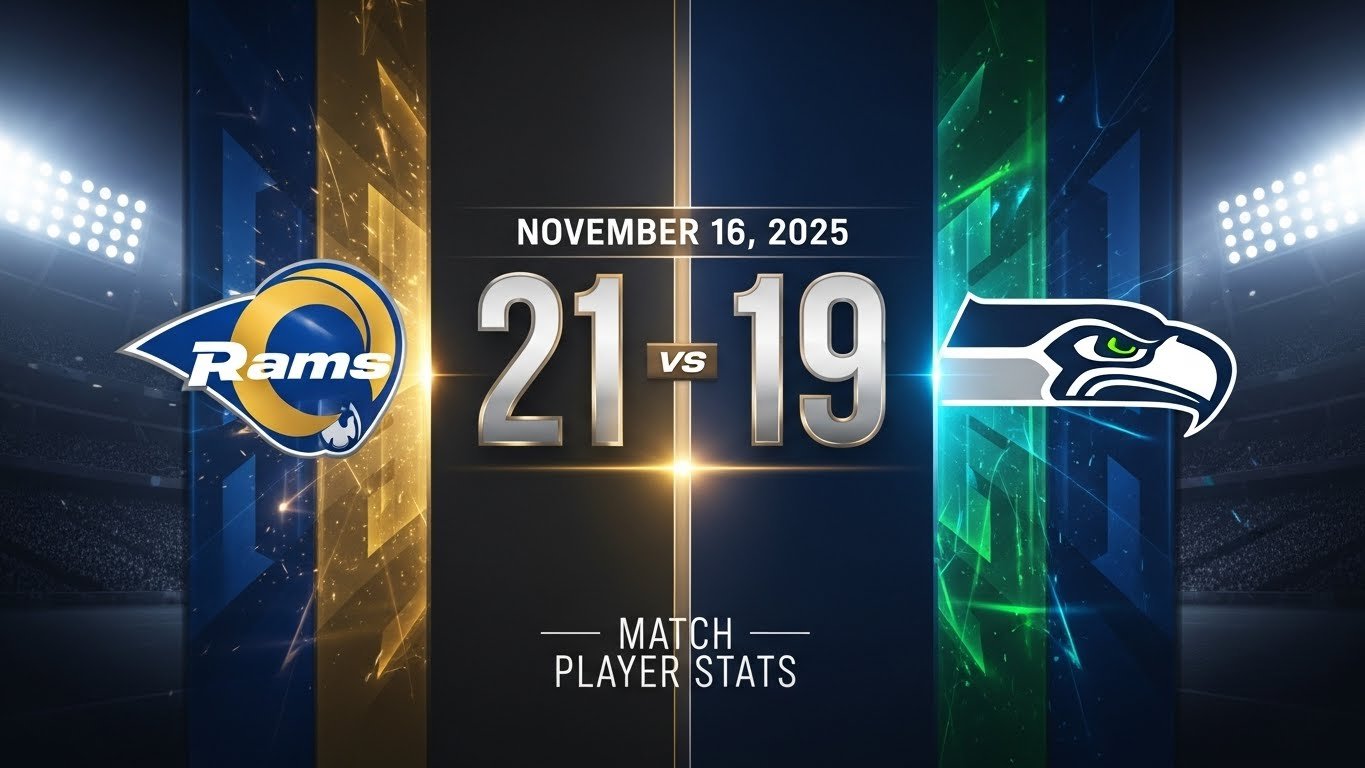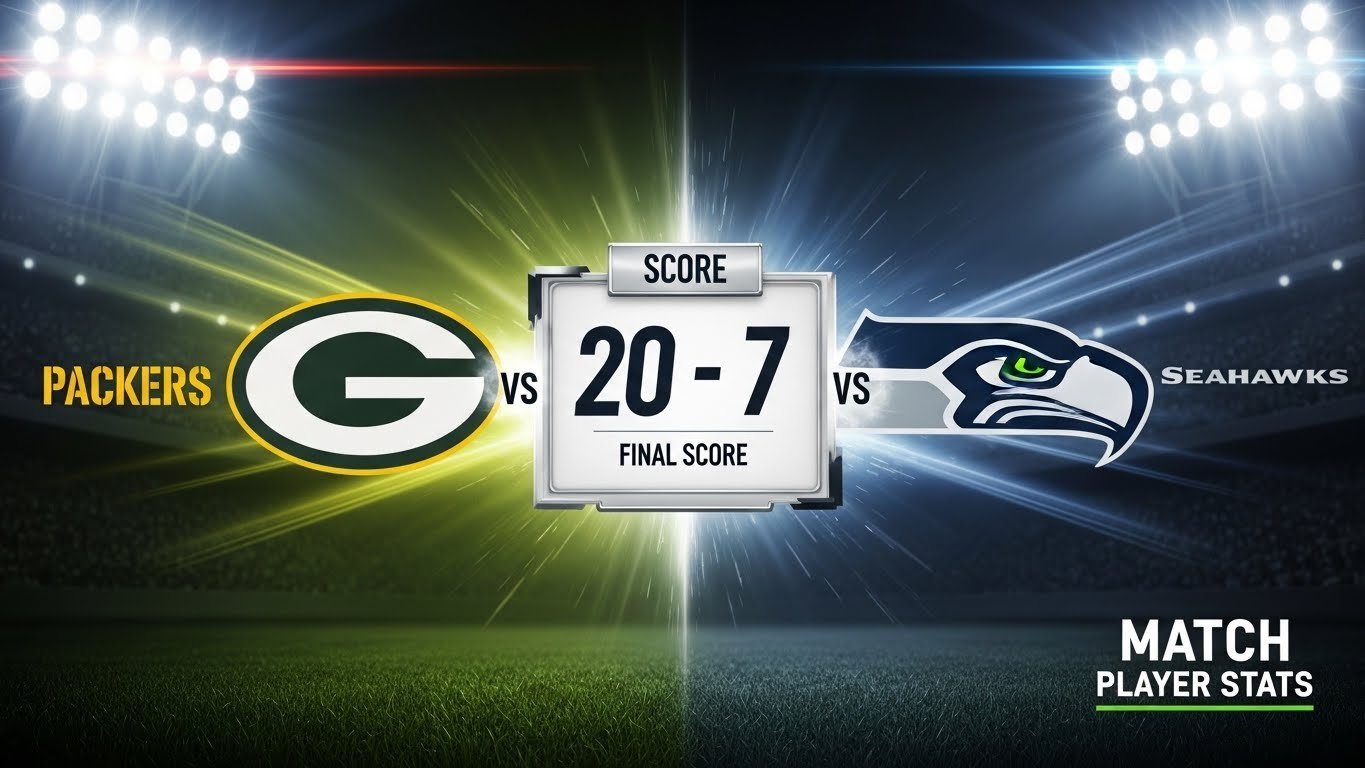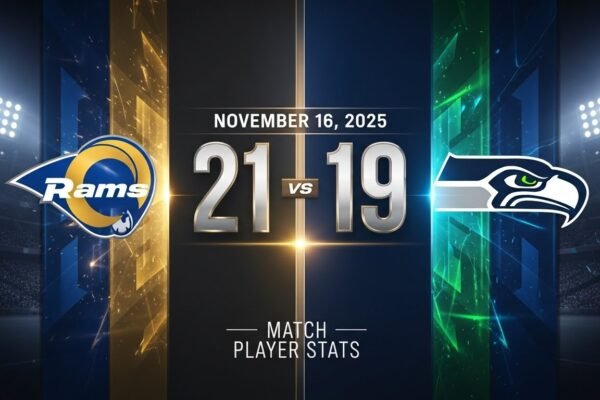
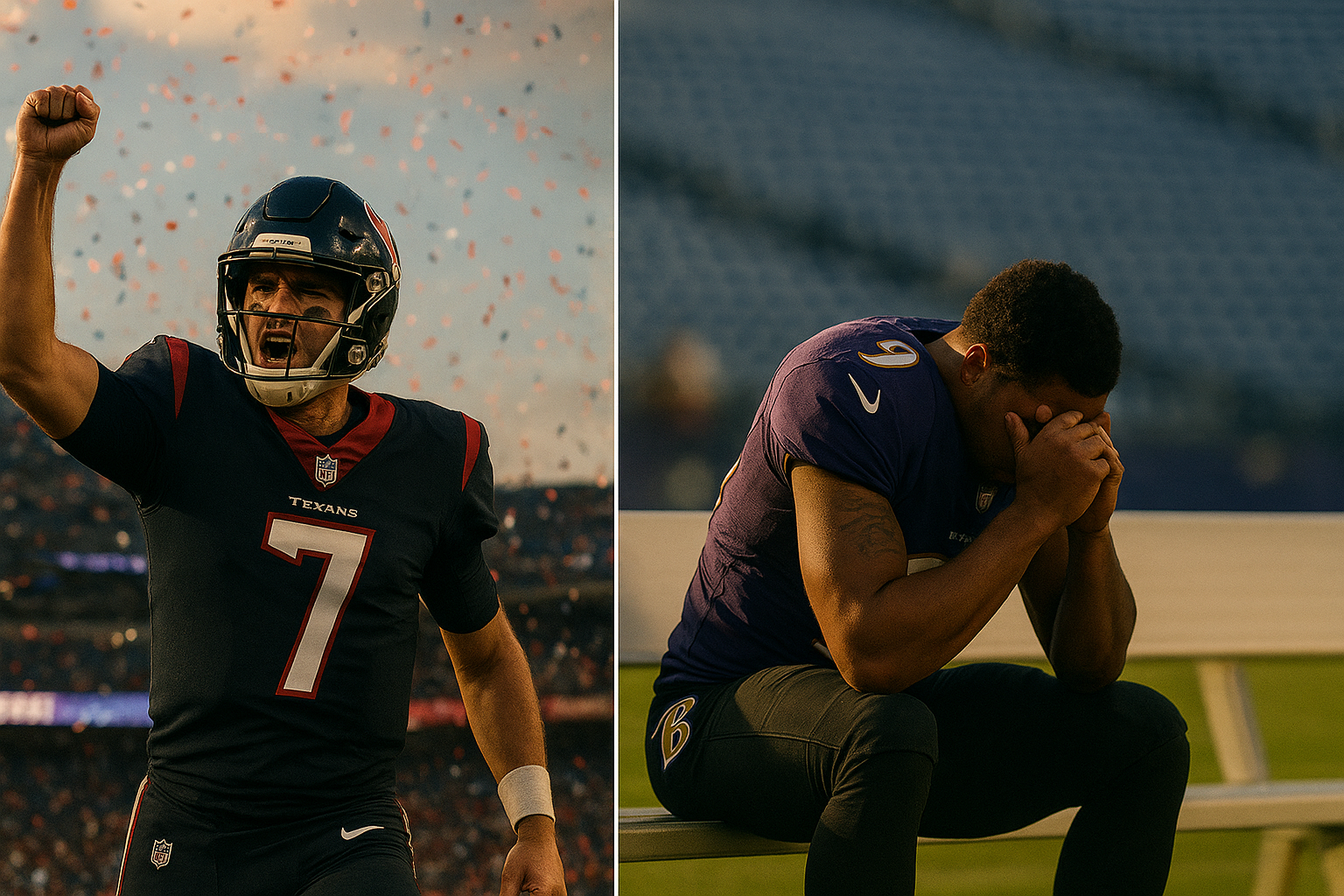
Baltimore Ravens vs Houston Texans Match Player Stats (Oct 5, 2025)
C.J. Stroud shredded Baltimore’s injury-depleted secondary for 244 yards and four touchdowns on 23-of-27 passing, leading Houston to a 44-10 rout at M&T Bank Stadium on October 5, 2025. Jalen Pitre grabbed two interceptions while Cooper Rush threw three picks behind a failing offensive line. The contrast in rushing attacks exposed everything: Nick Chubb gained 61 yards for Houston while Derrick Henry managed just 33 on 15 carries without Lamar Jackson’s scrambling threat keeping defenses honest.
Table of Contents
Final Score and Game Information
| Team | Q1 | Q2 | Q3 | Q4 | Final |
|---|---|---|---|---|---|
| Houston Texans | 7 | 17 | 10 | 10 | 44 |
| Baltimore Ravens | 3 | 0 | 7 | 0 | 10 |
Game Details
- Date: October 5, 2025
- Location: M&T Bank Stadium, Baltimore, MD
- Attendance: 70,077
- Time of Possession: HOU 36:33 / BAL 23:27
This tied Baltimore’s worst home loss in franchise history. The Ravens entered 1-3 and left 1-4. Houston won their second straight game to improve to 2-3 after starting 0-3.
Quarterback Statistics
The quarterback matchup wasn’t close. Stroud picked apart Baltimore’s secondary as Rush fought constant pressure from Houston’s defensive front.
Passing Performance
| Player | Team | Comp/Att | Yards | TD | INT | Sacks | Rating | QBR |
|---|---|---|---|---|---|---|---|---|
| C.J. Stroud | HOU | 23/27 | 244 | 4 | 0 | 2-17 | 143.9 | 99.4 |
| Cooper Rush | BAL | 14/20 | 179 | 0 | 3 | 1-16 | 58.1 | 30.6 |
| Davis Mills | HOU | 2/4 | 23 | 0 | 0 | 0-0 | 67.7 | 43.4 |
Efficiency Breakdown
| QB | Completion % | Yards/Attempt | Yards/Completion | Air Yards | YAC |
|---|---|---|---|---|---|
| C.J. Stroud | 85.2% | 9.0 | 10.6 | 206 | 77 |
| Cooper Rush | 70.0% | 9.0 | 12.8 | 163 | 83 |
Stroud’s 143.9 rating ranks among the season’s best through Week 5. He threw touchdowns to four different receivers and spread completions across eight targets. Stroud completed 85.2% of his passes, ranking in the 98th percentile for the week. When accounting for drops and throwaways, his adjusted completion percentage reached 88.9%.
Rush faced relentless pressure from a Texans front seven exploiting Baltimore’s inability to threaten them with Henry. The three turnovers buried any chance of staying competitive.
Rushing Attack Comparison
Baltimore’s offensive line couldn’t create running lanes for Henry. Houston averaged 5.1 yards per carry compared to Baltimore’s 2.3.
Individual Rushing Stats
| Player | Team | Attempts | Yards | Avg | TD | Long | Yards Before Contact |
|---|---|---|---|---|---|---|---|
| Nick Chubb | HOU | 11 | 61 | 5.5 | 1 | 27 | 2.7 |
| C.J. Stroud | HOU | 1 | 30 | 30.0 | 0 | 30 | 30.0 |
| Derrick Henry | BAL | 15 | 33 | 2.2 | 1 | 7 | 0.7 |
| Woody Marks | HOU | 7 | 24 | 3.4 | 0 | 11 | 0.4 |
| Dameon Pierce | HOU | 7 | 21 | 3.0 | 0 | 10 | 0.9 |
Team Rushing Totals
| Team | Attempts | Yards | Average | TDs | Long |
|---|---|---|---|---|---|
| Houston | 33 | 167 | 5.1 | 1 | 30 |
| Baltimore | 19 | 44 | 2.3 | 1 | 7 |
Chubb scored his 27-yard touchdown in the third quarter on an inside zone play. He found a seam, cut back, and raced into the end zone untouched.
The momentum shifted in the second quarter when Stroud scrambled for 30 yards facing third-and-3 from the Baltimore 34. Baltimore covered both his primary and secondary reads. He saw daylight up the middle, tucked the ball, and accelerated through the gap. Two offensive linemen cleared a path. Stroud reached the 4-yard line before stepping out, setting up first-and-goal. That single run outgained Henry’s entire first-half production of 8 yards.
Pass Catching Leaders
Top Receivers
| Player | Team | Targets | Rec | Yards | Avg | TD | Long | YAC |
|---|---|---|---|---|---|---|---|---|
| Zay Flowers | BAL | 5 | 5 | 72 | 14.4 | 0 | 56 | 29 |
| Christian Kirk | HOU | 4 | 4 | 64 | 16.0 | 0 | 47 | 20 |
| Dalton Schultz | HOU | 6 | 5 | 60 | 12.0 | 0 | 21 | 26 |
| Nico Collins | HOU | 5 | 4 | 52 | 13.0 | 1 | 24 | 16 |
| DeAndre Hopkins | BAL | 2 | 2 | 46 | 23.0 | 0 | 29 | 23 |
Touchdown Receptions
| Player | Team | Receptions | Yards | TDs |
|---|---|---|---|---|
| Xavier Hutchinson | HOU | 3 | 18 | 2 |
| Nico Collins | HOU | 4 | 52 | 1 |
| Jaylin Noel | HOU | 2 | 13 | 1 |
Xavier Hutchinson caught two red zone touchdowns. On Houston’s opening drive, Stroud hit him on a quick slant from 5 yards out. Hutchinson fought through contact to reach the end zone for the score that broke Houston’s three-game touchdown drought against Baltimore.
Right before halftime, Baltimore’s secondary lost him on a pick play. Hutchinson broke free from 10 yards out, and Stroud threw an easy touchdown pass with 28 seconds left in the half.
Flowers provided Baltimore’s only consistent threat through the air. In the third quarter, he beat rookie cornerback Kamari Lassiter on a deep route for a 56-yard gain, hauling in Rush’s best throw of the day. The catch set up Baltimore’s lone touchdown.
Defensive Statistics
Tackle Leaders and Impact Plays
| Player | Team | Tackles | Solo | Sacks | TFL | INT | PD | QB Hits |
|---|---|---|---|---|---|---|---|---|
| Teddye Buchanan | BAL | 15 | 8 | 0 | 1 | 0 | 0 | 0 |
| Malaki Starks | BAL | 10 | 3 | 0 | 0 | 0 | 0 | 0 |
| Trenton Simpson | BAL | 10 | 4 | 1 | 1 | 0 | 0 | 1 |
| E.J. Speed | HOU | 6 | 5 | 0 | 0 | 0 | 0 | 1 |
| Henry To’oTo’o | HOU | 5 | 3 | 0 | 1 | 0 | 0 | 0 |
| Jalen Pitre | HOU | 4 | 3 | 0 | 0 | 2 | 2 | 0 |
| Kamari Lassiter | HOU | 4 | 3 | 0 | 0 | 1 | 1 | 0 |
Takeaway Summary
| Team | Interceptions | Fumbles Lost | Total Turnovers |
|---|---|---|---|
| Houston | 0 | 0 | 0 |
| Baltimore | 3 | 0 | 3 |
Interception Breakdown:
- Jalen Pitre: 2 INT, 20 return yards
- Kamari Lassiter: 1 INT, 0 return yards
Pitre’s first interception sealed the game. Houston led 24-3 early in the third quarter when Rush forced a wheel route to Henry down the left sideline under duress. Pitre had studied the tendency on film, jumped the throw at the Baltimore 46, and secured the interception before getting tackled after an 8-yard return.
Three plays later, Chubb’s cutback run extended the lead to 31-3.
Pitre struck again in the fourth quarter. Rush stared down tight end Mark Andrews on a flat route from the Baltimore 33. Pitre stepped in front for an easy interception, nearly taking it back for a touchdown before Andrews tackled him at the 21.
Lassiter ended Baltimore’s final scoring threat late in the fourth quarter. Rush tried hitting Rashod Bateman deep down the right sideline. Lassiter maintained inside position, undercut Bateman’s break, and made a routine catch for the turnover.
Pass Rush Production
| Player | Team | Pressures | Sacks | Hits | Hurries |
|---|---|---|---|---|---|
| Will Anderson Jr. | HOU | 4 | 0 | 0 | 4 |
| Mario Edwards Jr. | HOU | 1 | 1 | 0 | 0 |
| Trenton Simpson | BAL | 2 | 1 | 1 | 0 |
| Kyle Van Noy | BAL | 2 | 1 | 0 | 1 |
Anderson won repeatedly against right tackle Roger Rosengarten through speed rushes and inside moves. He generated four hurries but couldn’t finish with sacks as Stroud’s quick release neutralized the pressure.
Simpson’s sack came from a well-timed blitz up the A-gap in the second quarter. He shot through untouched and dropped Stroud for a 9-yard loss.
Special Teams Performance
| Kicker | Team | FG Made/Att | Long | XP Made/Att | Points |
|---|---|---|---|---|---|
| Ka’imi Fairbairn | HOU | 3/3 | 57 | 5/5 | 14 |
| Tyler Loop | BAL | 1/2 | 27 | 1/1 | 4 |
Fairbairn converted field goals from 50, 57, and 34 yards. The 57-yarder in the third quarter pushed Houston’s lead to 34-3, prompting another wave of fans to exit M&T Bank Stadium.
Loop connected from 27 yards on Baltimore’s opening drive but pushed a 55-yard attempt wide right just before halftime.
Complete Team Statistics
| Category | Houston | Baltimore |
|---|---|---|
| First Downs | 27 | 12 |
| Total Yards | 417 | 207 |
| Passing Yards | 250 | 163 |
| Rushing Yards | 167 | 44 |
| Yards Per Play | 6.3 | 5.2 |
| 3rd Down Efficiency | 7-12 (58.3%) | 3-8 (37.5%) |
| 4th Down Efficiency | 1-1 (100%) | 0-0 |
| Red Zone Scoring | 4-5 (80%) | 1-2 (50%) |
| Penalties | 4-26 | 9-49 |
| Turnovers | 0 | 3 |
| Sacks Allowed | 2 | 1 |
Houston held possession for 13 more minutes than Baltimore. The Ravens ran just 45 plays compared to Houston’s 72, keeping the Texans defense fresh.
Baltimore committed nine penalties for 49 yards, including multiple false starts and a defensive holding that extended a Houston scoring drive.
How the Injury Crisis Shaped Everything
Without Lamar Jackson and several other key starters, Baltimore never had a chance. Safety Kyle Hamilton, linebacker Roquan Smith, cornerback Marlon Humphrey, tackle Ronnie Stanley, and fullback Patrick Ricard all missed the game due to injuries.
Multiple rookies started on defense, including safeties Malaki Starks and Reuben Lowery III, linebacker Teddye Buchanan, and cornerback Keyon Martin. These young players faced an uphill battle against Houston’s efficient offense.
Baltimore’s inexperienced secondary surrendered open receivers on multiple plays. On Hutchinson’s second touchdown, the pick play created immediate separation. The young defenders lost track of their assignments in the chaos.
Without Jackson’s scrambling threat, Houston loaded the box against the run on most plays. They dared Rush to beat them through the air behind a decimated offensive line missing Stanley at left tackle.
According to the official game recap from the Ravens, Baltimore entered hoping their defense could keep things close despite the offensive limitations. Houston scored touchdowns on its first three possessions.
Stroud’s Breakthrough Performance
After struggling in three previous meetings with Baltimore, Stroud finally broke through. He’d never led Houston to an offensive touchdown against the Ravens before this game.
The opening drive established his command. Stroud completed 6 of 8 passes for 62 yards on a 10-play march that consumed 5:36. He mixed quick passes with play action on the possession.
In the second quarter, Stroud made his best throw of the game. Baltimore brought pressure off the edge on a 10-yard touchdown pass to Collins, forcing Stroud to release quickly. He fit a tight spiral into a window between two defenders. The score extended Houston’s lead to 17-3.
DeMeco Ryans praised Stroud’s composure after the game. “He was very calm, he was very under control the entire game,” Ryans told reporters. “He didn’t get flustered.”
Stroud spread completions to eight different receivers, never forcing throws into coverage against Baltimore’s depleted secondary.
Rush’s Difficult Debut
Cooper Rush made his first start for Baltimore after joining the team in free agency. Pro Football Focus graded four of Baltimore’s five starting offensive linemen below 60.0, considered below average. Left tackle Joe Noteboom earned a 42.3 grade after getting beaten repeatedly by Danielle Hunter. Right guard Daniel Faalele checked in at 42.4, struggling against inside moves from Houston’s defensive tackles.
Rush threw three interceptions under different types of pressure. The first occurred when Will Anderson forced him off his spot with an outside speed rush. The second followed Trenton Simpson’s blitz up the middle that forced a quick throw. The third resulted from a clean pocket but poor anticipation of Lassiter’s break on the deep ball.
NFL.com’s game coverage quoted Ravens coach John Harbaugh admitting: “Obviously, we got beat in every way you can get beat. Very disappointed in that. Just a complete disappointment.”
Third Down and Red Zone Execution
Houston converted 58.3% of third downs compared to Baltimore’s 37.5%. Baltimore couldn’t convert third-and-short situations. They went 0-for-2 on third-and-3 or shorter. Rush absorbed a sack on one attempt, and Henry got stuffed on another after defenders penetrated the backfield.
Houston scored touchdowns on four of five red zone trips (80%). Their only field goal occurred after a holding penalty pushed them back to the 32-yard line.
Baltimore reached the red zone twice. They kicked a field goal on their opening drive and scored a touchdown in garbage time during the third quarter. Both possessions required more than 10 plays and seven minutes combined.
Key Moments That Decided the Outcome
Opening Drive (Q1, 15:00-9:25)
Houston’s 10-play, 67-yard march consumed over five minutes. Stroud completed 6 of 8 passes, mixing quick throws to Schultz and Kirk with a key third-down conversion to Collins. Hutchinson’s 5-yard touchdown catch ended the drive and broke Houston’s drought of no offensive touchdowns in three straight games against Baltimore.
Stroud’s Scramble (Q2, 8:00)
With Houston leading 10-3 and facing third-and-3 from the Baltimore 34, this single play shifted momentum permanently. Stroud’s 30-yard scramble set up first-and-goal from the 4-yard line. One play later, Stroud hit Collins for a touchdown that ballooned the advantage to 17-3 and put Baltimore in a two-possession hole.
Pitre’s First Interception (Q3, 12:57)
Baltimore had just received the second-half kickoff trailing 24-3. They desperately needed a sustained scoring drive. Pitre’s interception at the Baltimore 46 ended that hope immediately. Houston scored three plays later when Chubb burst through for 27 yards. The score reached 31-3, and large sections of M&T Bank Stadium began emptying.
Fairbairn’s 57-Yard Field Goal (Q3, 5:53)
After the Chubb touchdown, Houston’s offense stalled near midfield. Facing fourth-and-2 from the Baltimore 39, the Texans sent out Fairbairn. He crushed the 57-yarder with room to spare. The kick stretched the margin to 34-3 and triggered another mass exodus from the stands.
Historical Context
This 34-point defeat tied Baltimore’s worst home loss in franchise history. The Ravens previously lost 41-7 to New England in 2013, also a 34-point margin.
For Houston, the 44 points matched their highest road output in franchise history. They’d scored 41 on the road three previous times, most recently against Tennessee in 2011.
The victory marked only Houston’s third win over Baltimore in franchise history. The Ravens had won the previous six meetings, including a 31-2 Christmas Day beatdown less than 10 months earlier.
According to Pro Football Reference box score data, this was just the third time Baltimore allowed 40 or more points at home.
The loss dropped Baltimore to 1-4, their worst start since 2015 when they finished 5-11 and made major roster changes.
Season Implications
Baltimore’s defense entered Week 5 ranked 31st in points allowed. They’d surrendered 40, 38, and 37 points in their three previous losses. Adding 44 more to that total deepened the crisis facing a team with playoff aspirations.
Houston’s victory gave them back-to-back wins heading into their Week 6 bye. The Texans had started 0-3 with losses to Indianapolis, Minnesota, and Jacksonville before beating New England in Week 4.
Stroud’s performance validated the offensive potential when healthy weapons surrounded him. Collins, Kirk, and Schultz all won their matchups consistently when the quarterback had time to throw.
The contrast to Baltimore’s January playoff dominance felt stark. Just nine months earlier, the Ravens had crushed Pittsburgh 28-14 in the Wild Card round with Jackson and Henry combining for 267 rushing yards. That version of Baltimore, with their stars healthy and firing, had imposed their will physically and controlled nearly 40 minutes of possession. This depleted October squad couldn’t control anything and desperately needed Jackson, Hamilton, and Smith back before their playoff hopes evaporated.
Advanced Metrics and Efficiency Stats
Houston averaged 6.3 yards per play compared to Baltimore’s 5.2. Over 72 offensive snaps for the Texans, that 1.1-yard advantage per play created the yardage gap that led to scoring opportunities.
Expected Points Added (EPA) per play revealed the dominance. Houston posted +0.364 EPA per play on offense. Baltimore managed -0.334 EPA per play, a full 0.7-point swing per snap.
Houston’s defense held Baltimore to -0.334 EPA per play and just 5.2 yards per snap. They forced three turnovers worth approximately 9 expected points combined.
Complete Scoring Summary
| Quarter | Time | Scoring Play | Score |
|---|---|---|---|
| 1st | 9:25 | Xavier Hutchinson 5-yard TD pass from C.J. Stroud (Ka’imi Fairbairn kick) | HOU 7, BAL 0 |
| 1st | 1:58 | Tyler Loop 27-yard field goal | HOU 7, BAL 3 |
| 2nd | 11:18 | Ka’imi Fairbairn 50-yard field goal | HOU 10, BAL 3 |
| 2nd | 5:36 | Nico Collins 10-yard TD pass from C.J. Stroud (Ka’imi Fairbairn kick) | HOU 17, BAL 3 |
| 2nd | 0:28 | Xavier Hutchinson 10-yard TD pass from C.J. Stroud (Ka’imi Fairbairn kick) | HOU 24, BAL 3 |
| 3rd | 11:33 | Nick Chubb 27-yard TD run (Ka’imi Fairbairn kick) | HOU 31, BAL 3 |
| 3rd | 5:53 | Ka’imi Fairbairn 57-yard field goal | HOU 34, BAL 3 |
| 3rd | 2:41 | Derrick Henry 1-yard TD run (Tyler Loop kick) | HOU 34, BAL 10 |
| 4th | 13:48 | Jaylin Noel 4-yard TD pass from C.J. Stroud (Ka’imi Fairbairn kick) | HOU 41, BAL 10 |
| 4th | 10:30 | Ka’imi Fairbairn 34-yard field goal | HOU 44, BAL 10 |
Houston built a 24-3 halftime lead and never faced a serious threat in the second half. Baltimore’s lone touchdown occurred with the outcome already decided, cutting the deficit from 31 points to 24 briefly before Houston answered with two more scores.
Houston’s systematic dismantling of Baltimore through the air and on the ground validated their offensive adjustments after starting 0-3. Stroud’s efficiency and Pitre’s opportunistic defense created a performance that ranks among the most lopsided games in this AFC rivalry. For Baltimore at 1-4, getting Jackson, Hamilton, and Smith healthy became priority number one. The 44-10 final score reflected Houston’s preparation meeting Baltimore’s depleted roster at the worst possible moment.
Game statistics sourced from Pro Football Reference and ESPN and verified against official team data. Individual play descriptions verified through broadcast footage and official play-by-play logs.

